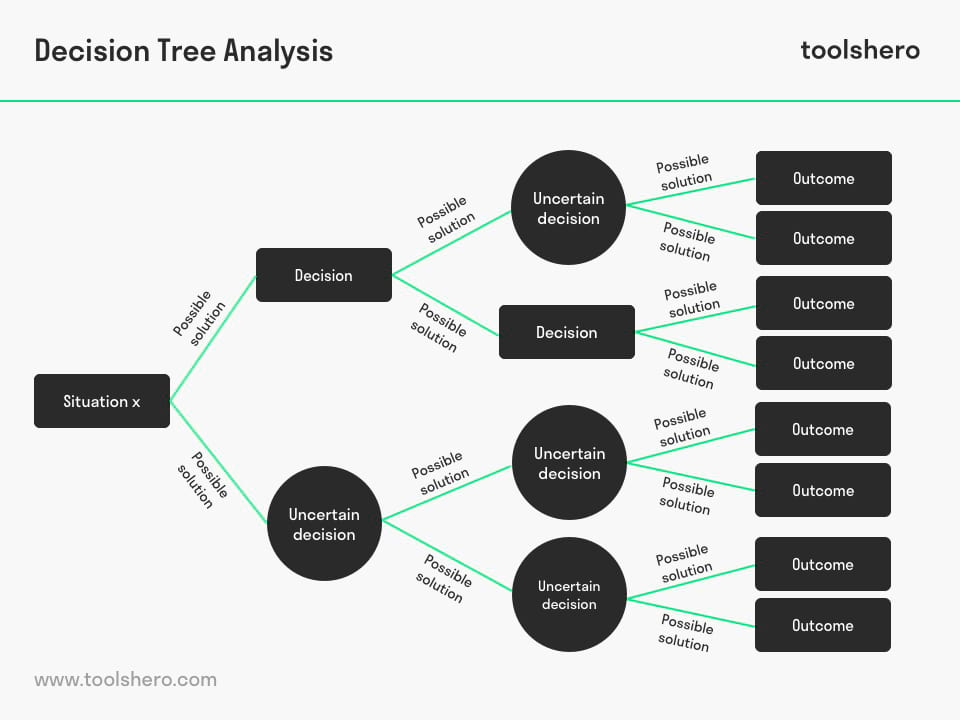Decision Tree Analysis

Decision Tree Analysis: this article describes the Decision Tree Analysis in a practical way. Next to what it is, this article also higlights the process, the “What if” thought, Visualization and Representation, a practical Decision Tree Analysis example. This article also contains a downloadable and editable template. After reading you will understand the basics of this powerful decision making and process analysis approach. Enjoy reading!
What is a Decision Tree Analysis?
The decision tree diagram is a decision making tool for decision makers. It is a graphic representation of various alternative solutions that are available to solve a problem. The manner of illustrating often proves to be decisive when making a choice.
A Decision Tree Analysis is created by answering a number of questions that are continued after each affirmative or negative answer until a final choice for a complex decision can be made.
Decision making process
The Decision Tree Analysis tool is a scientific model and is often used in the decision making process of organizations. When making a decision, the management already envisages alternative ideas and solutions.
By using a decision tree, the alternative solutions and possible choices are illustrated graphically as a result of which it becomes easier to make a well-informed choice.
This graphic representation is characterized by a tree-like structure in which the problems in decision making can be seen in the form of a flowchart, each with branches for alternative choices.
What if
The Decision Tree Analysis makes good use of the ‘what if’ thought. There are several alternatives that consider both the possible risks and benefits that are brought about by certain choices.
The possible alternatives are also made clearly visible and therefore the decision tree provides clarity with respect to the consequences of any decisions that will be made.
Visualization and Representation
There are several ways in which a decision tree can be represented. This Analysis is commonly represented by lines, squares and circles. The squares represent decisions, the lines represent consequences and the circles represent uncertain outcomes. By keeping the lines as far apart as possible, there will be plenty of space to add new considerations and ideas and to create a new course of action.
The representation of the decision tree can be created in four steps:
- Describe the decision that needs to be made in the square.
- Draw various lines from the square and write possible solutions on each of the lines.
- Put the outcome of the solution at the end of the line. Uncertain or unclear decisions are put in a circle. When a solution leads to a new decision, the latter can be put in a new square.
- Each of the squares and circles are reviewed critically so that a final choice can be made.

Figure 1 – the Decision Tree Analaysis model
A practical Decision Tree Analysis example
Suppose a commercial company wishes to increase its sales and the associated profits in the next year.
The different alternatives can then be mapped out by using a decision tree. There are two choice for both increase of sales and profits: 1- expansion of advertising expenditure and 2- expansion of sales activities. This creates two branches. Two new choices arise from choice 1, namely 1-1 a new advertising agency and 1-2 using the services of the existing advertising agency. Choice 2 presents two follow-up choices in turn; 2-1-working with agents or 2-2- using its own sales force.
The branching continues.
The following alternatives from 1-1 are:
1-1-1 The budget will increase by 10% -> end result: sales up 6%, profits up 2%
1-1-2 The budget will increase by 5% -> end result: sales up 4%, profits up 1.5 %
The alternatives that arise from 1.2:
1-2-1 The budget increases by 10% -> end result: sales up 5%, profits up 2.5%
1-2-2 The budget increases by 5 % -> end result: a sales up 4%, profits up 12%
From 2.1 possibly follows:
2-1-1 Set up with own dealers -> end result: sales up 20%, profits up 5%
2-1-2 Working with existing dealers -> end result: sales up 12.5%, profit up 8%
From 2.2 possibly follows:
2-2-1 Hiring of new sales staff -> end result: sales up 15%, profits up 5%
2-2-2 Motivating of existing sales staff -> end result: sales up 4%, profits up 2%.

Figure 2: an example of a Decision tree
The above example illustrates that, in all likelihood, the company will opt for final outcome 1-2-2, because the forecast of this decision is that profits will increase by 12%.
This Analysis is particularly useful in situations in which it is considered desirable to develop various alternatives and potential outcomes of decisions in a structured manner as this will present a clear substantiation.
This method is increasingly used by medical practitioners and technicians as it enables them to make a diagnosis or determine car problems.
Decision Tree Analysis template
Start describing the different aspects of the Decision Tree Analysis with this ready to use Decision Tree Analysis template.
Download the Decision Tree Analysis template
This template is exclusively for our paying Toolshero members. Click here to see if a membership is something for you!It’s Your Turn
What do you think? Is the Decision Tree Analysis applicable in today’s modern business process environment? Do you recognize the practical explanation or do you have more additions? What are your success factors regarding the Decision Tree Analysis? Do you use this tool to calcuate the unexpected? What are advantages and disadvantages of this tool compared to other tools for decision making? Do you find it difficult to draw a decision tree?
Share your experience and knowledge in the comments box below.
More information
- Duncan, R. (1980). What is the right organization structure? Decision tree analysis provides the answer. Organizational Dynamics, 7(3), 59-80.
- Kim, J. K., Song, H. S., Kim, T. S., & Kim, H. K. (2005). Detecting the change of customer behavior based on decision tree analysis. Expert Systems, 22(4), 193-205.
- Prager, M. (2011). Decisions Decisions Decisions: How To Prune Your Decision Tree And Get What You Really Want. Ebook.
- Skinner, D. C. (2009). Introduction to Decision Analysis. Probabilistic Publishing.
How to cite this article:
Mulder, P. (2017). Decision Tree Analysis. Retrieved [insert date] from toolshero: https://www.toolshero.com/decision-making/decision-tree-analysis/
Original publication date: 02/27/2017 | Last update: 12/10/2023
Add a link to this page on your website:
<a href=”https://www.toolshero.com/decision-making/decision-tree-analysis/”>Toolshero: Decision Tree Analysis</a>












